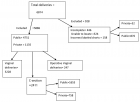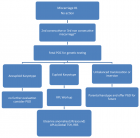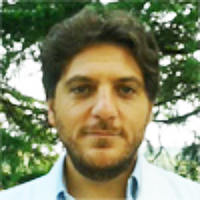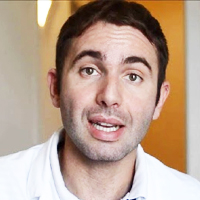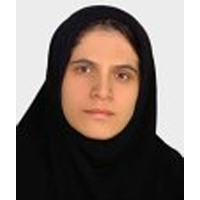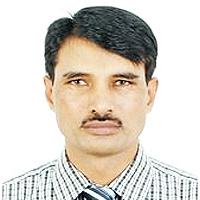Figure 2
Overview of Interferon: Characteristics, signaling and anti-cancer effect
Kangjian Zhang*, Huaiyuan Wang and Haijun Hu
Published: 25 April, 2017 | Volume 1 - Issue 1 | Pages: 001-016
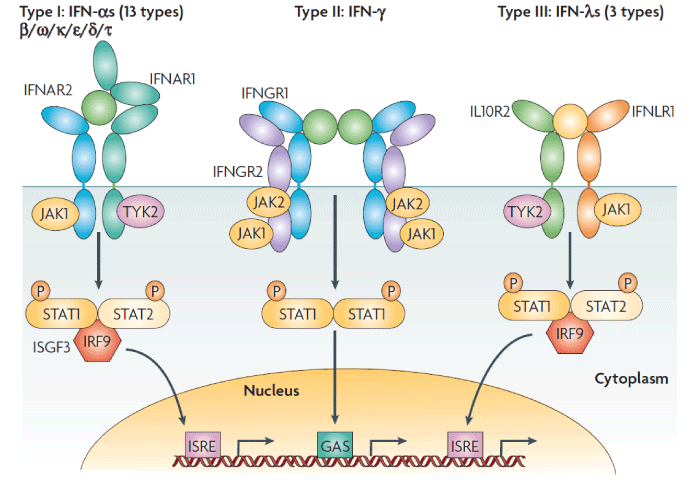
Figure 2:
Receptor activation signalling pathways by type I, type II or type III interferons. Type I interferons (IFNs) (α, β ω, κ, ε, δ (pigs), τ (ruminants)) interact with IFN (α, β and ω) receptor 1 (IFNAR1) and IFNAR2; type II IFN-γ with IFN-γ receptor 1 (IFNGR1) and IFNGR2; and type III IFN-λs with IFN-λ receptor 1 (IFNLR1; also known as IL28RA) and interleukin 10 receptor 2 (IL10R2; also known as IL10RB). Type II IFN-γ is an antiparallel homodimer exhibiting a two-fold axis of symmetry. It binds two IFNGR1 receptor chains, assembling a complex that is stabilized by two IFNGR2 chains. These receptors are associated with two kinases from the JAK family: JAK1 and TYK2 for type I and III IFNs; JAK1 and JAK2 for type II IFN. All IFN receptor chains belong to the class 2 helical cytokine receptor family, which is defined by the structure of the extracellular domains of their members: approximately 200 amino acids structured in two subdomains of 100 amino acids (fibronectin type III modules), themselves structured by seven β‑strands arranged in a β‑sandwich. The 200 amino-acids domain usually contain the ligand binding site. IFNAR2, IFNLR1, IL10R2, IFNGR1 and IFNGR2 are classical representatives of this family, while IFNAR1 is atypical as its extracellular domain is duplicated. GAS, IFN-γ-activated site; IRF9, IFN regulatory factor 9; ISGF3, IFN-stimulated gene factor 3, refers to the STAT1–STAT2–IRF9 complex; ISRE, IFN-stimulated response element; P, phosphate; STAT1/2, signal transducers and activators of transcription 1/2.
Read Full Article HTML DOI: 10.29328/journal.hjb.1001001 Cite this Article Read Full Article PDF
More Images
Similar Articles
-
Overview of Interferon: Characteristics, signaling and anti-cancer effectKangjian Zhang*,Huaiyuan Wang,Haijun Hu. Overview of Interferon: Characteristics, signaling and anti-cancer effect. . 2017 doi: 10.29328/journal.hjb.1001001; 1: 001-016
Recently Viewed
-
Reducing CO2 in Passive House Adapted Low-cost Tropical Homes?Karl Wagner*. Reducing CO2 in Passive House Adapted Low-cost Tropical Homes?. J Clin Adv Dent. 2024: doi: 10.29328/journal.jcad.1001040; 8: 009-012
-
Pharmacovigilance is Important for Assessments of Drugs, and Withdrawal of the Drugs that have Adverse Effects More than The Benefits of Their TreatmentRezk R Ayyad,Yasser Abdel Allem Hassan,Ahmed R Ayyad*. Pharmacovigilance is Important for Assessments of Drugs, and Withdrawal of the Drugs that have Adverse Effects More than The Benefits of Their Treatment. Arch Pharm Pharma Sci. 2025: doi: 10.29328/journal.apps.1001069; 9: 042-045
-
Comparative Activities of Stem Bark Extracts of Anthocleista vogelii, Bligha sapida, Voacanga africana and Momordica charantia Leaf against Plasmodium berghei- berghei in MiceSamuel Akintunde Odediran*,Adeleke Stephen Adesida,Ayomipo Olumuyiwa Adegeye. Comparative Activities of Stem Bark Extracts of Anthocleista vogelii, Bligha sapida, Voacanga africana and Momordica charantia Leaf against Plasmodium berghei- berghei in Mice. Arch Pharm Pharma Sci. 2025: doi: 10.29328/journal.apps.1001068; 9: 031-041
-
Transnasal Humidified Rapid-Insufflation Ventilatory Exchange (THRIVE) in High-Risk Endoscopic Procedures: A Non-Intubation ApproachNaba Madoo*,Vaibhavi Baxi. Transnasal Humidified Rapid-Insufflation Ventilatory Exchange (THRIVE) in High-Risk Endoscopic Procedures: A Non-Intubation Approach. Int J Clin Anesth Res. 2025: doi: 10.29328/journal.ijcar.1001033; 9: 035-036
-
Primary Gluteal Hydatid Cyst: A Case ReportMohammed Alssir Ibrahim Mustafa Mohammed Ahmed*,Abdelmahmoud Mohammed Alabas Abushaiba. Primary Gluteal Hydatid Cyst: A Case Report. Arch Surg Clin Res. 2025: doi: 10.29328/journal.ascr.1001090; 9: 038-041
Most Viewed
-
Feasibility study of magnetic sensing for detecting single-neuron action potentialsDenis Tonini,Kai Wu,Renata Saha,Jian-Ping Wang*. Feasibility study of magnetic sensing for detecting single-neuron action potentials. Ann Biomed Sci Eng. 2022 doi: 10.29328/journal.abse.1001018; 6: 019-029
-
Evaluation of In vitro and Ex vivo Models for Studying the Effectiveness of Vaginal Drug Systems in Controlling Microbe Infections: A Systematic ReviewMohammad Hossein Karami*, Majid Abdouss*, Mandana Karami. Evaluation of In vitro and Ex vivo Models for Studying the Effectiveness of Vaginal Drug Systems in Controlling Microbe Infections: A Systematic Review. Clin J Obstet Gynecol. 2023 doi: 10.29328/journal.cjog.1001151; 6: 201-215
-
Prospective Coronavirus Liver Effects: Available KnowledgeAvishek Mandal*. Prospective Coronavirus Liver Effects: Available Knowledge. Ann Clin Gastroenterol Hepatol. 2023 doi: 10.29328/journal.acgh.1001039; 7: 001-010
-
Causal Link between Human Blood Metabolites and Asthma: An Investigation Using Mendelian RandomizationYong-Qing Zhu, Xiao-Yan Meng, Jing-Hua Yang*. Causal Link between Human Blood Metabolites and Asthma: An Investigation Using Mendelian Randomization. Arch Asthma Allergy Immunol. 2023 doi: 10.29328/journal.aaai.1001032; 7: 012-022
-
An algorithm to safely manage oral food challenge in an office-based setting for children with multiple food allergiesNathalie Cottel,Aïcha Dieme,Véronique Orcel,Yannick Chantran,Mélisande Bourgoin-Heck,Jocelyne Just. An algorithm to safely manage oral food challenge in an office-based setting for children with multiple food allergies. Arch Asthma Allergy Immunol. 2021 doi: 10.29328/journal.aaai.1001027; 5: 030-037

HSPI: We're glad you're here. Please click "create a new Query" if you are a new visitor to our website and need further information from us.
If you are already a member of our network and need to keep track of any developments regarding a question you have already submitted, click "take me to my Query."







